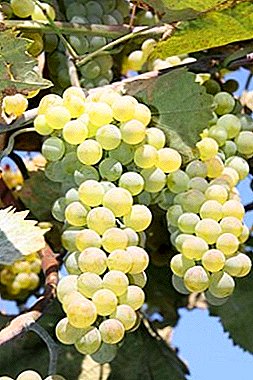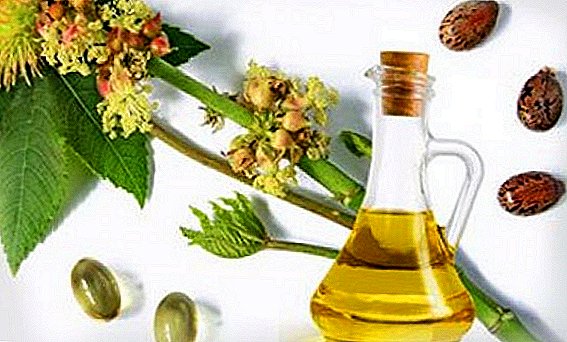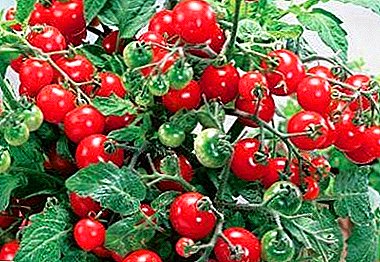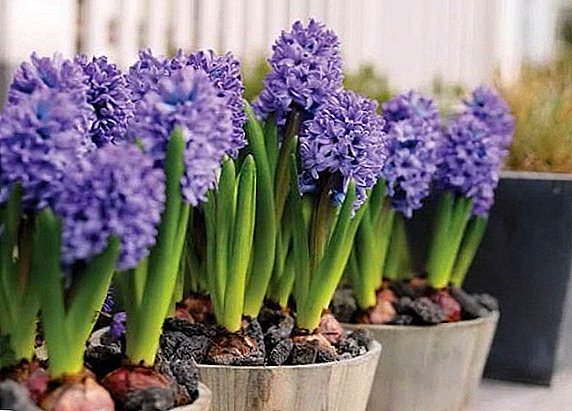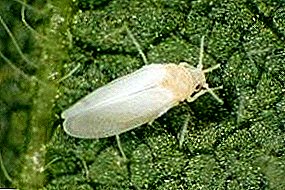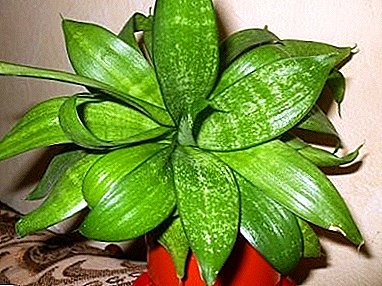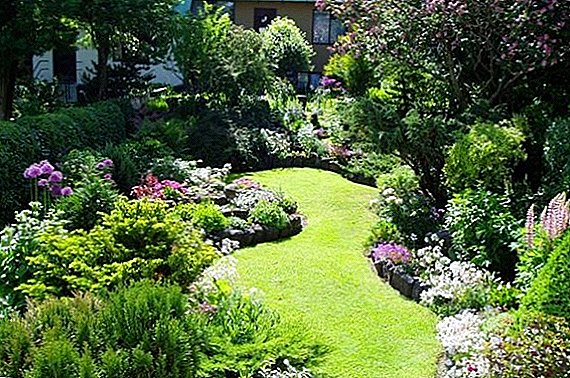 The design of the suburban area, its decoration can be a real source of pride for the owner. Rock gardens and rockeries, single plants and group compositions will bring a special personality to the dull landscape. In this article we will get acquainted with the popular decorative trees for the garden, their photos with the names.
The design of the suburban area, its decoration can be a real source of pride for the owner. Rock gardens and rockeries, single plants and group compositions will bring a special personality to the dull landscape. In this article we will get acquainted with the popular decorative trees for the garden, their photos with the names.
Abelia
Abelia belongs to the family of honeysuckle, this genus includes more than thirty species, which are most common in Southeast Asia.
These are large deciduous shrubs or small trees that grow up to four meters in height in their natural environment. The trees have gray bark, older specimens are lighter than the young ones.
Strong shoots covered with oblong leaves with serrated edges, they are located opposite. The leaf plate is large - up to 6 cm, with a short scape.  In the first month of summer tubular inflorescences bloom, which are collected in bunches on the branches. The flowers are small, with a pleasant aroma, pale pink color.
In the first month of summer tubular inflorescences bloom, which are collected in bunches on the branches. The flowers are small, with a pleasant aroma, pale pink color.
After a long period of flowering small fruits appear with a dense skin, oblong, about a centimeter in length.
The plant likes nutritious, aerated soils with good drainage, sun or light shade. Abelia is propagated by seeds, cuttings and root shoots. She is beautiful both in a group and in single plantings.
Popular species and varieties:



Akebia
Akebia is an exotic plant originally from Japan. Chocolate Liana, as it is called, is common in the Caucasus, in the Crimea, in Europe, Australia and North America, Korea and China. This curly ornamental shrub, growing in length to six meters. The plant is deciduous, it can be evergreen.
Purple creeper shoots with red tint. The leaves are bright green, divided into five parts. Akebia is interesting because on one shoot two kinds of flowers perfectly coexist:


In the middle of spring, the inflorescences bloom and fill everything around with a coffee aroma. Later, the fruits appear blueberry shade, from 6 to 8 cm long, oblong shape. Fruits also have a pleasant smell and taste. In the middle of autumn, the fruits open up and open ripe black seeds.
Akebia likes to grow in a place lit by the sun, she needs support. Propagated by seeds, cuttings and layering. In our latitudes, the five-ackeba and the three-leafed abekia take root.
Did you know? Akebia is not only a beautiful background in the garden: sweet fruits are a popular dessert in cooking, and stuffed with meat as a main course. Shoots creepers serve as material for weaving baskets. Buds, shoots are medicinal raw materials, and seasoning is made from flowers and leaves.

Rosemary
Ledum has up to ten species, it belongs to the heather family, distributed in Siberia and the Far East. In its natural environment, it prefers to grow in forests with moist soil along streams.
Branches and foliage of wild rosemary because of the essential oils in the composition emit a sharp and unpleasant smell. This is an evergreen shrub with dense leaves with slightly curled edges. In autumn, the foliage acquires a dark brown shade, usually it is dark green.
Ledum rose blooms with thyroid or umbrella inflorescences, male and female on a single plant. Fruits - boxes with five nests with small seed-lioners.  Cultivated plant propagated by cuttings, root shoots, layering and dividing the bush.
Cultivated plant propagated by cuttings, root shoots, layering and dividing the bush.
Did you know? In the leather industry for the treatment of leather used essential oils of wild rosemary. And the smell of plants repels mosquitoes and moths, if you put the leaves in the closet, where there is fur.
Best-selling types of wild rosemary: marsh and large-leaved.
Euonymus
Under natural conditions, mixed and deciduous forests, there are up to 200 species of euonymus. Only twenty of them have taken root in our latitudes.
The euonymus is one of the most beautiful trees for the dacha, its lush ornate crown made it the most popular plant in landscape design. Tree shoots are covered with open dark green foliage. Sheet plate is smooth, with a clear vein in the center.
In May, the plant blooms with small greenish flowers, gathered in thyroid or racemose inflorescences.  But the most spectacular spectacle will begin in September: there will appear fruits in the form of lanterns from four divisions in which multicolored seeds are hidden. Foliage at this time will acquire many colors and shades: from yellow and carmine to blood red and dark burgundy.
But the most spectacular spectacle will begin in September: there will appear fruits in the form of lanterns from four divisions in which multicolored seeds are hidden. Foliage at this time will acquire many colors and shades: from yellow and carmine to blood red and dark burgundy.
Even a single sheet can combine several bright colors. A riot of colors can be observed until frost.
Important! After the seed boxes burst, make sure that they are not picked up by pets. Seeds contain poisonous alkaloids.
Cultural species of euonymus: 


Hawthorn
Hawthorn is an unpretentious winter-hardy plant, so its range of distribution is quite large, it does not grow only in the Far North. These are deciduous trees and shrubs, which can often be seen on the edge of a forest, on mountain slopes, glades and in flood plains.
Hawthorn branches sprinkled with spines, hard, protruding straight. The leaves are oval-shaped, pointed to the edge, green.
Hawthorn blooms in May, flowering period to June. Lush thyroid inflorescences are covered with small white flowers with an unusual aroma.  At the end of the summer dark-red fruits ripen round shape, sour taste. Inside the fruit about three seeds, surrounded by powdery pulp.
At the end of the summer dark-red fruits ripen round shape, sour taste. Inside the fruit about three seeds, surrounded by powdery pulp.
Growing hawthorn will not deliver labor, and more than one generation will enjoy the fruits of this labor. The plant is a long-lived, living under good conditions for up to three hundred years. Therefore, it is often used as a hedge. Popular types of hawthorn:



Elder
Elderberry is an ornamental deciduous shrub; As can be seen in the photo and as the name suggests, the fruits of the plant are inky black. Elderberry grows in mixed and coniferous forests, it is often accompanied by quinoa and nettle. The plant is both medicinal and poisonous.
Important! If there are small children in the family, make sure that they do not eat elderberry. In the natural environment, they are avoided even by animals.
 Elderberry has gray-brown bark, branched trunk and flexible shoots. Growing, the crown forms a soft hemisphere. The foliage is large, oblong, with a clear central vein.
Elderberry has gray-brown bark, branched trunk and flexible shoots. Growing, the crown forms a soft hemisphere. The foliage is large, oblong, with a clear central vein.In May, the bush is covered with white, gathered in a brush with small flowers. Flowering continues through the month of July. After it begins to ripen the fruit - the berries of ink color.
The elder is propagated in three ways: by seeds, layering and cuttings. It is in demand among elder gardeners of the following varieties:




Heather
Heather grows on all continents, most often near peat bogs and pine forests. Sometimes it fills a very large area, popularly called heathlands.
This evergreen low shrub with branching stem. Small, fairly dense triangular green leaves are more like spines.
Clustery inflorescences with small purple flowers bloom in July-August. The shape of flowers resembles an inverted glass. It is noteworthy that dried flowers do not fly around, creating a blooming appearance until late autumn.
Heather is a wonderful melliferous plant, to which even literary works are devoted, for example, Stevenson's ballad Heather Honey.
Grow a plant is easy, the main thing - regular watering, especially in the heat. Popular varieties:




Wisteria
Wisteria is a deciduous tree with beautiful clusters of flowers, as seen in the photo. In Latin its name is Wisteria. This is a deciduous tree-like liana with drooping shoots that twist around any support, stretching to 15 meters.
Bright green leaves sit on a long petiole in pairs, in young plants they are pubescent.
Wisteria has a long flowering period: from March to the end of summer. Fluffy brush inflorescences white, pink and blue shades fall from the branches in bright waves. The length of the brushes can be more than 30 cm.
The plant does not bloom immediately after planting: Chinese wisteria at the age of three, Japanese ten years later.
Important! When growing, be careful with nitrogen fertilizers, with its excess, wisteria may not bloom, increasing the foliar mass.Popular types:




Viburnum
Kalina ordinary from the honeysuckle family is a decorative-deciduous shrub growing up to four meters in height. The area of its distribution is the countries of Europe and Asia with a temperate climate, Russia, the Caucasus, the Crimea, Ukraine.
Kalina prefers the banks of rivers and lakes, deciduous and mixed forests, meadows and logging, but with moist soil.
The bark of the branches is gray or yellow-brown, naked. The leaves are large, sitting oppositely, dark green, the leaf plate is divided into three to five parts, covered with a network of veins with deeper central ones. The lower part of the leaf plate is pubescent, the upper is smooth.  In May, viburnum is covered with white, thyroid, not too fluffy buds. Toward the end of August, rounded fruits ripen. Orange at first, they gradually fill with red. Berries bitter to taste with one seed inside.
In May, viburnum is covered with white, thyroid, not too fluffy buds. Toward the end of August, rounded fruits ripen. Orange at first, they gradually fill with red. Berries bitter to taste with one seed inside.
The drupe of viburnum is flat, sometimes in the shape of a heart. Both aboveground and underground parts of the plant are medicinal raw materials. Especially popular in our gardens viburnum "Buldenezh", thanks to the beautiful snow-white spherical inflorescences. Other varieties:



Rowan
The mountain ash is a tall, up to fifteen meters tall tree or shrub with a thick, slightly elongated crown. The bark is gray, smooth. The shoots are pubescent, with gray buds with a red tint.
The leaves are alternate, from 9 to 13 pieces of oblong sheet plates on one long petiole. The edges of the leaves are jagged, with a clear vein in the center, by the autumn they become red.
Paniculate or umbrella white, sometimes with a pinkish tinge, inflorescences appear in late spring. In September, the fruits begin to ripen in the shape of an apple. Bitter and astringent red-orange peas love the remaining birds to spend the winter.
Rowan unpretentious, it is winter-hardy, well tolerated shade. It has beautiful decorative forms: pyramidal and weeping.
Best-selling varieties:



Sorbokotoneaster
Sorbokotoneaster - a hybrid, obtained by crossing a Siberian mountain ash and black agile fruit cotter. The plant grows in a limited area and is listed in the Red Book of the Russian Federation.
It is a shrub up to three meters high with gray-brown, wrinkled bark. The branches of the hybrid can be brown or dark red. The shape and color of the leaves are the same as those of mountain ash or cotoneaster.
Leaf plate, pubescent from the bottom, up to 7 cm long. In the autumn season, the leaves become multi-colored, taking on shades of yellow, pink and red.  At the beginning of summer white or cream blossoms, thyroid or racemes appear. At the end of July, round fruits, dark, almost black, ripen. The aroma and taste of mountain ash, but without the characteristic bitterness.
At the beginning of summer white or cream blossoms, thyroid or racemes appear. At the end of July, round fruits, dark, almost black, ripen. The aroma and taste of mountain ash, but without the characteristic bitterness.
The decorative bush is unpretentious, is not afraid of a shade and frosts, prefers nutritious soil. Propagated by seeds, retaining the features of both parents, and cuttings of the current year. Culture is represented by one species.
Sumac
Sumy - shrub or tree, genus, numbering about 250 species, growing on almost all continents. This is a low, up to five meters, tree with a wide hemispherical, spreading crown.
Crooked bare branches of gray color are covered with dense greens. Complicated leaves consist of many oddnopistochnye leaves, with a jagged edge, velvety to the touch surface, in the fall take a crimson color.
Pyramidal, protruding upwards like candles, panicles of inflorescences adorn the tree at the beginning of summer. After flowering, round-shaped fruit of a bright orange or carmine color is tied.  Sumy is not capricious, grows on all types of soil, sometimes freezes, but quickly recovers. In our climatic conditions, sumac deer-horny or furry is more adapted.
Sumy is not capricious, grows on all types of soil, sometimes freezes, but quickly recovers. In our climatic conditions, sumac deer-horny or furry is more adapted.
Hionantus
Hionanthus virginsky is the most adapted species for our climate. In nature, deciduous tree or shrub reaches ten meters in height. Chionanthus has crooked shoots with longitudinal wrinkles of gray.
The bright green oval-shaped leaves are separated by a vein in the center. The sheet plate is large, up to 20 cm long and 9 cm wide, dense, glossy. Autumn leaves turn yellow, taking bright shades, and at the end of October, completely flies.
In May-June hionantus blooms. Flowering short, no more than three weeks. Drooping paniculate white inflorescences consist of unusual flowers: they look like a carelessly collected bunch of narrow ribbons.
In late September, the fruits ripen in ink color, but this phenomenon is rare even in the homeland of hionanthus.  Khionanthus prefers to grow on loams with a neutral reaction, likes regular but moderate watering. In the winter, plants, especially young ones, need to be carefully covered.
Khionanthus prefers to grow on loams with a neutral reaction, likes regular but moderate watering. In the winter, plants, especially young ones, need to be carefully covered.
Bird cherry
Bird cherry - a large shrub or tree up to ten meters high, common in Europe, Asia, North Africa, in the post-Soviet space.
The bird cherry is almost black, matte bark, thin flexible shoots and lush dense crown. The leaves are alternate, simple, oval-shaped, pointed at the tip, with a finely toothed margin. The leaf plate on the long scape is supplied with spinous stipules that quickly fly around.
Blossoms in May-June, racemes white, sometimes pale pink inflorescences, consisting of many small five-petal cups. Towards the end of August, fruits of the color of thick ink ripen in a round regular shape.
Bird cherry breeding cuttings and root shoots. Loves lighting, fertile, well-moistened soil. The plant is winter hardy. Aerial parts of the bird cherry are used as medicinal raw materials.
Views for our latitudes:



Exojorda
An exochorda is a deciduous shrub of the pink family. Growing up to four meters in height, the bush has a spreading crown, gray-brown or dark gray bark and strong shoots.
Leaves are light green, alternate, without stipules, with notches along the edge. In the middle of May the bush is covered with white flowers. Lush inflorescences form about fifteen cupped flowers up to 5 cm in diameter. The flowering period is short - up to three weeks.
The culture is drought-resistant and frost-resistant, but it still needs regular watering, and for the winter young plants need shelter.
Popular varieties of exochords:
Ornamental shrubs in the garden can perform many functions. High can be used as a living fence, dwarf as curbs, you can hide unsightly areas of the garden with the help of vines wrapping around the support, to zone the area. Include fantasy, and let your garden pleases the view all year round.




